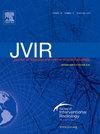子宫肌瘤择期子宫动脉栓塞术后 30 天的医疗服务情况,有无下腹上神经阻滞。
IF 2.6
3区 医学
Q2 PERIPHERAL VASCULAR DISEASE
Journal of Vascular and Interventional Radiology
Pub Date : 2025-02-01
DOI:10.1016/j.jvir.2024.10.019
引用次数: 0
摘要
目的:评估子宫肌瘤子宫动脉栓塞术(UAE)期间实施胃下上神经阻滞术(SHNB)对当日出院和30天内就诊(HE)的影响。材料与方法:回顾性研究了2018年1月至2022年12月期间成功接受UAE治疗子宫肌瘤的240例患者。30天内的医疗事件,包括急诊科(ED)和紧急护理就诊、入院和再入院,被分为早期(出院后0-7天)和晚期(出院后8-30天),以及与介入放射学(IR)护理相关或无关的医疗事件。通过单变量分析确定了与当天出院和 HE 相关的因素。使用卡方检验比较了基于 SHNB 状态的 HE 发生率:平均年龄为 46 ± 5 岁;125 名患者接受了 UAE 和 SHNB。与未接受 SHNB 的患者(55/115,48%)相比,接受 SHNB 的患者当天出院的几率明显更高(113/125,90%)(p结论:与单纯做 UAE 相比,做了 SHNB 的 UAE 患者当天出院率明显更高,但 30 天的医疗就诊率却相差无几。本文章由计算机程序翻译,如有差异,请以英文原文为准。

Thirty-Day Healthcare Encounters after Elective Uterine Artery Embolization for Fibroids with and without Superior Hypogastric Nerve Block
Purpose
To evaluate how the implementation of superior hypogastric nerve block (SHNB) during uterine artery embolization (UAE) for uterine fibroids impacts same-day discharge and healthcare encounters (HCEs) within 30 days.
Materials and Methods
A total of 240 patients who underwent successful UAE for fibroids between January 2018 and December 2022 were retrospectively reviewed. HCEs within 30 days, including emergency department and urgent care visits, admissions, and readmissions, were categorized as early (0–7 days of discharge) and late (8–30 days of discharge) and related or unrelated to interventional radiology (IR) care. Factors associated with same-day discharge and HCE were identified using univariate analyses. Rates of HCE based on SHNB status were compared using the chi-square tests.
Results
The mean age of the patients was 46 years (SD ± 5); 125 patients received UAE with SHNB. Patients who underwent SHNB were significantly more likely to undergo same-day discharge (113/125, 90%) than those without SHNB (55/115, 48%) (P < .001). No factors were associated with rates of all-cause 30-day HCE, including SHNB status (SHNB, 17% [21/125], versus no SHNB, 10% [12/115]; P = .20). A majority of HCEs were due to an IR-related cause (26/33, 79%), including abdominal or pelvic pain (22/33, 67%); nausea, vomiting, or poor oral intake (18/33, 55%); and vaginal bleeding (4/33, 12%). Comparison of patients who underwent SHNB with those without SHNB showed no difference in the proportion of IR-related HCE (17/21 [81%] versus 9/12 [75%], P = .69).
Conclusions
UAE with SHNB was associated with significantly higher rates of same-day discharge but similar rates of 30-day HCEs compared with UAE alone.
求助全文
通过发布文献求助,成功后即可免费获取论文全文。
去求助
来源期刊
CiteScore
4.30
自引率
10.30%
发文量
942
审稿时长
90 days
期刊介绍:
JVIR, published continuously since 1990, is an international, monthly peer-reviewed interventional radiology journal. As the official journal of the Society of Interventional Radiology, JVIR is the peer-reviewed journal of choice for interventional radiologists, radiologists, cardiologists, vascular surgeons, neurosurgeons, and other clinicians who seek current and reliable information on every aspect of vascular and interventional radiology. Each issue of JVIR covers critical and cutting-edge medical minimally invasive, clinical, basic research, radiological, pathological, and socioeconomic issues of importance to the field.

 求助内容:
求助内容: 应助结果提醒方式:
应助结果提醒方式:


